Demonstration-Based and Attention-Enhanced Grid-Tagging Network for Mention Recognition
Abstract
1. Introduction
- Based on the analysis of practical results obtained from mining mentions of paraphrases in the Chinese dictionary using W2NER, we address the issue of insufficient semantic information in short texts. Furthermore, with the rise of Large Language Models (LLMs), in-context learning theory performs excellently in its performance by feeding a few task-related samples, which is widely applied in the field of Natural Language Processing (NLP) [8]. Concatenating task-related demonstration in the input text as a prompt is also an advantage for normal-scale models. To enhance the learning ability, inspired by task-specific demonstration proposed in GPT-3 [9], we introduce the concept of in-context learning. Following specific selection strategies, it samples inputs and labels from the training data, designs task-specific demonstration templates, constructs corresponding demonstration sequences, concatenates them with input sentences, and provides information enhancement. Simultaneously, it improves the model’s ability to learn from limited samples.
- To address the issue of lower accuracy in recognizing entities or concepts in discontinuous scenarios with the base model, we introduce a multi-head attention mechanism to capture attention scores for words at different positions based on different labels. The attention features of labels are embedded into the model. Additionally, an iterative mechanism is employed to update the representations of label attention, aiming to extract deep fusion features.
- To tackle the problem of attention mechanisms losing sequence information, this paper introduces rotary position embedding [10], achieving relative encoding effects in an absolute embedding form. Additionally, we then propose an improved algorithm W2NER [3], named the Demonstration and Tag attention Enhanced Grid-Tagging Network (DTaE). The overall architecture of DTaE is illustrated in Figure 1.
- This study selected an authoritative Chinese dictionary and employed a five-person annotation method to annotate flat, nested, and discontinuous entities and concepts in the definitions. Experiments were conducted on the public dataset CADEC [11] and the Chinese dictionary dataset to validate the effectiveness of the proposed model.
2. Related Work
3. Methods
- Searching for demonstration sentences: During the training phase, a certain search strategy is employed to sample input sequences and corresponding annotated data from the training set. Task-specific demonstration templates are designed, and the obtained input sequences and annotated data are filled into these templates to construct demonstrations. Relevant demonstration sequences are concatenated with input sequences, playing a role in task demonstration and information enhancement.
- Word feature extraction and sentence feature enhancement: pre-trained models are used to embed input sequences, obtaining word features and sentence features. The demonstration information is also embedded using the same pre-trained model, resulting in a sentence vector indicated by the “[CLS]” token. This vector is weighted using learnable weights and fused with the input sequence’s sentence vector to enhance the features. Furthermore, Bi-LSTM networks are utilized to embed the representation vectors of input sequences, introducing more semantic context information.
- Construction of two-dimensional grid features: The vector representations of the input text are concatenated with position embedding and upper-triangular matrices to create BERT-style input. Conditional Layer Normalization is applied to merge grid representations.
- Hybrid Dilation Convolution (HDC) for extracting two-dimensional features: Convolutional networks are naturally suited for extracting two-dimensional features. Although single fine-grained dilated convolutions can enlarge the receptive field, they face the grid effect: as the dilation rate increases, the input sampling becomes sparse, potentially leading to the loss of local information. Multiple fine-grained mixed dilated convolutions are used to extract grid features, enlarging the receptive field while avoiding the grid effect and effectively extracting two-dimensional features.
- Obtaining tag attention features: Tagging features are constructed, and multi-head attention mechanisms capture the attention weights of different labels at different positions in the input sequence. These attention features are iteratively updated to enhance the model’s recognition ability. To address the issue of attention mechanisms losing sequence position information, rotary position embedding is introduced in a relative embedding form, achieving results similar to absolute embedding. This embedding advantage is fully utilized by incorporating rotary position embedding before the aforementioned multi-head attention mechanism.
- Deepening features: Word-pair grid features and tag attention features are iteratively fused through multiple rounds of the steps mentioned in (4) and (5).
- Joint classifier: A joint classifier consisting of a multilayer perceptron and biaffine predictors predicts the word-pair relationships for various grid indicators.
- Decoding: Based on the predicted word-pair relationships within the grid, the decoding algorithm is applied to obtain flat, nested, and discontinuous entities and concepts in the input sequence.
3.1. Demonstration Search
3.2. Sequence Embedding
3.3. Grid Feature Extraction
3.4. Label Representation Embedding
3.5. Joint Prediction and Decoding
4. Experiment
4.1. Dataset
4.2. Evaluation Metrics
4.3. Experimental Results and Analysis
- On the public dataset CADEC, this study compares various typical models in recent years and validates the improvement effect of the proposed DTaE grid-tagging algorithm for unified entity and concept mining tasks.
- On the Chinese Dictionary dataset, a comparison is made with the baseline model W2NER.
- The study validates the significant improvement of the proposed DTaE model in unified entity and concept recognition tasks.
- On the public dataset CADEC, ablation experiments are conducted to verify the effectiveness of the introduced demonstration search module, multi-head attention mechanism, and rotary position embedding in the improved DTaE model.
- On the non-sequential data from the public dataset CADEC, a comparison is made with the base model W2NER to validate the effectiveness of the proposed DTaE grid-tagging algorithm in non-sequential scenarios and its capability to learn from fewer samples.
5. Conclusions
6. Limitation and Future Work
Supplementary Materials
Author Contributions
Funding
Data Availability Statement
Conflicts of Interest
References
- Murphy, G. The Big Book of Concepts; MIT Press: Cambridge, MA, USA, 2004. [Google Scholar]
- Yan, H.; Gui, T.; Dai, J.; Guo, Q.; Zhang, Z.; Qiu, X. A unified generative framework for various NER subtasks. arXiv 2021, arXiv:2106.01223. [Google Scholar]
- Li, J.; Fei, H.; Liu, J.; Wu, S.; Zhang, M.; Teng, C.; Ji, D.; Li, F. Unified named entity recognition as word-word relation classification. In Proceedings of the AAAI Conference on Artificial Intelligence, Virtual, 22 February–1 March 2022. [Google Scholar]
- Hu, Y.; He, H.; Chen, Z.; Zhu, Q.; Zheng, C. A unified model using distantly supervised data and cross-domain data in NER. Comput. Intell. Neurosci. 2022, 2022, 1987829. [Google Scholar] [CrossRef] [PubMed]
- Lu, J.; Zhao, R.; Mac Namee, B.; Tan, F. Punifiedner: A prompting-based unified ner system for diverse datasets. In Proceedings of the AAAI Conference on Artificial Intelligence, Washington, DC, USA, 7–14 February 2023. [Google Scholar]
- Zhang, S.; Shen, Y.; Tan, Z.; Wu, Y.; Lu, W. De-bias for generative extraction in unified NER task. In Proceedings of the 60th Annual Meeting of the Association for Computational Linguistics, Dublin, Ireland, 22–27 May 2022; Long Papers. Volume 1, pp. 808–818. [Google Scholar]
- Liu, J.; Ji, D.; Li, J.; Xie, D.; Teng, C.; Zhao, L.; Li, F. TOE: A grid-tagging discontinuous NER model enhanced by embedding tag/word relations and more fine-grained tags. IEEE/ACM Trans. Audio Speech Lang. Process. 2022, 31, 177–187. [Google Scholar] [CrossRef]
- Min, S.; Lyu, X.; Holtzman, A.; Artetxe, M.; Lewis, M.; Hajishirzi, H.; Zettlemoyer, L. Rethinking the role of demonstrations: What makes in-context learning work? arXiv 2022, arXiv:2202.12837. [Google Scholar]
- Brown, T.; Mann, B.; Ryder, N.; Subbiah, M.; Kaplan, J.D.; Dhariwal, P.; Neelakantan, A.; Shyam, P.; Sastry, G.; Askell, A. Language models are few-shot learners. Adv. Neural Inf. Process. Syst. 2020, 33, 1877–1901. [Google Scholar]
- Su, J.; Lu, Y.; Pan, S.; Murtadha, A.; Wen, B.; Liu, Y. Roformer: Enhanced transformer with rotary position embedding. arXiv 2021, arXiv:2104.09864. [Google Scholar] [CrossRef]
- Karimi, S.; Metke-Jimenez, A.; Kemp, M.; Wang, C. CADEC: A corpus of adverse drug event annotations. J. Biomed. Inform. 2015, 55, 73–81. [Google Scholar] [CrossRef] [PubMed]
- Wang, Z.; Xu, X.; Li, X.; Li, H.; Wei, X.; Huang, D. An Improved Nested Named-Entity Recognition Model for Subject Recognition Task under Knowledge Base Question Answering. Appl. Sci. 2023, 13, 11249. [Google Scholar] [CrossRef]
- Huang, P.; Zhao, X.; Hu, M.; Tan, Z.; Xiao, W. T 2-NER: AT wo-Stage Span-Based Framework for Unified Named Entity Recognition with T emplates. Trans. Assoc. Comput. Linguist. 2023, 11, 1265–1282. [Google Scholar] [CrossRef]
- Jiang, X.; Song, C.; Xu, Y.; Li, Y.; Peng, Y. Research on sentiment classification for netizens based on the BERT-BiLSTM-TextCNN model. PeerJ Comput. Sci. 2022, 8, e1005. [Google Scholar] [CrossRef]
- Tang, X.; Huang, Y.; Xia, M.; Long, C. A Multi-Task BERT-BiLSTM-AM-CRF Strategy for Chinese Named Entity Recognition. Neural Process. Lett. 2023, 55, 1209–1229. [Google Scholar] [CrossRef]
- Li, D.; Yan, L.; Yang, J.; Ma, Z. Dependency syntax guided bert-bilstm-gam-crf for chinese ner. Expert Syst. Appl. 2022, 196, 116682. [Google Scholar] [CrossRef]
- Li, W.; Du, Y.; Li, X.; Chen, X.; Xie, C.; Li, H.; Li, X. UD_BBC: Named entity recognition in social network combined BERT-BiLSTM-CRF with active learning. Eng. Appl. Artif. Intell. 2022, 116, 105460. [Google Scholar] [CrossRef]
- Zhang, W.; Meng, J.; Wan, J.; Zhang, C.; Zhang, J.; Wang, Y.; Xu, L.; Li, F. ChineseCTRE: A Model for Geographical Named Entity Recognition and Correction Based on Deep Neural Networks and the BERT Model. ISPRS Int. J. Geo. Inf. 2023, 12, 394. [Google Scholar] [CrossRef]
- Ju, M.; Miwa, M.; Ananiadou, S. A neural layered model for nested named entity recognition. In Proceedings of the 2018 Conference of the North American Chapter of the Association for Computational Linguistics: Human Language Technologies, Orleans, LA, USA, 1–6 June 2018; Long Papers. Volume 1. [Google Scholar]
- Shibuya, T.; Hovy, E. Nested named entity recognition via second-best sequence learning and decoding. Trans. Assoc. Comput. Linguist. 2020, 8, 605–620. [Google Scholar] [CrossRef]
- Tang, B.; Hu, J.; Wang, X.; Chen, Q. Recognizing continuous and discontinuous adverse drug reaction mentions from social media using LSTM-CRF. Wirel. Commun. Mob. Comput. 2018, 2018, 2379208. [Google Scholar] [CrossRef]
- Su, J.; Murtadha, A.; Pan, S.; Hou, J.; Sun, J.; Huang, W.; Wen, B.; Liu, Y. Global pointer: Novel efficient span-based approach for named entity recognition. arXiv 2022, arXiv:2208.03054. [Google Scholar]
- Zaratiana, U.; Tomeh, N.; Holat, P.; Charnois, T. GNNer: Reducing overlapping in span-based NER using graph neural networks. In Proceedings of the 60th Annual Meeting of the Association for Computational Linguistics: Student Research Workshop, Dublin, Ireland, 22–27 May 2022. [Google Scholar]
- Zaratiana, U.; Tomeh, N.; Holat, P.; Charnois, T. Named Entity Recognition as Structured Span Prediction. In Proceedings of the Workshop on Unimodal and Multimodal Induction of Linguistic Structures (UM-IoS), Abu Dhabi, United Arab Emirates, 7–8 December 2022. [Google Scholar]
- Wan, J.; Ru, D.; Zhang, W.; Yu, Y. Nested named entity recognition with span-level graphs. In Proceedings of the 60th Annual Meeting of the Association for Computational Linguistics, Dublin, Ireland, 22–27 May 2022; Long Papers. Volume 1. [Google Scholar]
- Fisher, J.; Vlachos, A. Merge and label: A novel neural network architecture for nested NER. arXiv 2019, arXiv:1907.00464. [Google Scholar]
- Sohrab, M.G.; Miwa, M. Deep exhaustive model for nested named entity recognition. In Proceedings of the 2018 Conference on Empirical Methods in Natural Language Processing, Brussels, Belgium, 31 October–4 November 2018. [Google Scholar]
- Li, F.; Wang, Z.; Hui, S.C.; Liao, L.; Zhu, X.; Huang, H. A segment enhanced span-based model for nested named entity recognition. Neurocomputing 2021, 465, 26–37. [Google Scholar] [CrossRef]
- Su, J.; Yu, H. Unified Named Entity Recognition as Multi-Label Sequence Generation. In Proceedings of the 2023 International Joint Conference on Neural Networks (IJCNN), Gold Coast, Australia, 18–23 June 2023. [Google Scholar]
- Straková, J.; Straka, M.; Hajič, J. Neural architectures for nested NER through linearization. arXiv 2019, arXiv:1908.06926. [Google Scholar]
- Tan, Z.; Shen, Y.; Zhang, S.; Lu, W.; Zhuang, Y. A sequence-to-set network for nested named entity recognition. arXiv 2021, arXiv:2105.08901. [Google Scholar]
- Lewis, M.; Liu, Y.; Goyal, N.; Ghazvininejad, M.; Mohamed, A.; Levy, O.; Stoyanov, V.; Zettlemoyer, L. Bart: Denoising sequence-to-sequence pre-training for natural language generation, translation, and comprehension. arXiv 2019, arXiv:1910.13461. [Google Scholar]
- Hu, N.; Zhou, X.; Xu, B.; Liu, H.; Xie, X.; Zheng, H.-T. VPN: Variation on Prompt Tuning for Named-Entity Recognition. Appl. Sci. 2023, 13, 8359. [Google Scholar] [CrossRef]
- Lee, D.-H.; Kadakia, A.; Tan, K.; Agarwal, M.; Feng, X.; Shibuya, T.; Mitani, R.; Sekiya, T.; Pujara, J.; Ren, X. Good examples make a faster learner: Simple demonstration-based learning for low-resource NER. arXiv 2021, arXiv:2110.08454. [Google Scholar]
- Gao, T.; Fisch, A.; Chen, D. Making pre-trained language models better few-shot learners. arXiv 2020, arXiv:2012.15723. [Google Scholar]
- Chen, Z.; Qian, T. Description and demonstration guided data augmentation for sequence tagging. World Wide Web 2022, 25, 175–194. [Google Scholar] [CrossRef]
- Wang, Y.; Yu, B.; Zhu, H.; Liu, T.; Yu, N.; Sun, L. Discontinuous named entity recognition as maximal clique discovery. arXiv 2021, arXiv:2106.00218. [Google Scholar]
- Lynch, C.J.; Jensen, E.J.; Zamponi, V.; O’Brien, K.; Frydenlund, E.; Gore, R. A Structured Narrative Prompt for Prompting Narratives from Large Language Models: Sentiment Assessment of ChatGPT-Generated Narratives and Real Tweets. Future Internet 2023, 15, 375. [Google Scholar] [CrossRef]
- Zeng, D.; Liu, K.; Lai, S.; Zhou, G.; Zhao, J. Relation classification via convolutional deep neural network. In Proceedings of the COLING 2014, the 25th International Conference on Computational Linguistics: Technical Papers, Dublin, Ireland, 23–29 August 2014. [Google Scholar]
- Wang, L.; Cao, Z.; De Melo, G.; Liu, Z. Relation classification via multi-level attention cnns. In Proceedings of the 54th Annual Meeting of the Association for Computational Linguistics, Berlin, Germany, 7–12 August 2016; Long Paper. Volume 1. [Google Scholar]
- Reimers, N.; Gurevych, I. Sentence-bert: Sentence embeddings using siamese bert-networks. arXiv 2019, arXiv:1908.10084. [Google Scholar]
- Wang, B.; Lu, W. Combining spans into entities: A neural two-stage approach for recognizing discontiguous entities. arXiv 2019, arXiv:1909.00930. [Google Scholar]
- Fei, H.; Ji, D.; Li, B.; Liu, Y.; Ren, Y.; Li, F. Rethinking boundaries: End-to-end recognition of discontinuous mentions with pointer networks. In Proceedings of the AAAI Conference on Artificial Intelligence, Vancouver, BC, Canada, 2–9 February 2021. [Google Scholar]
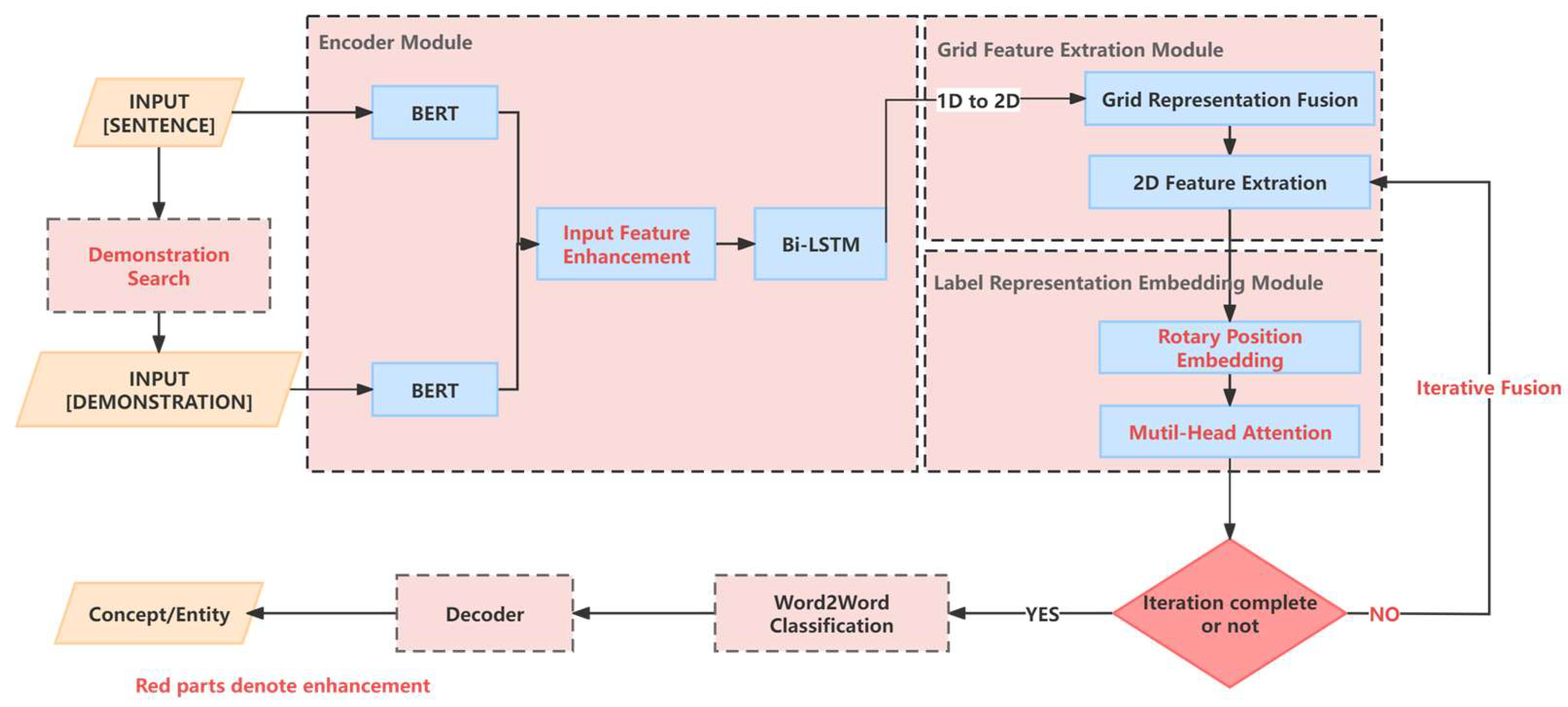
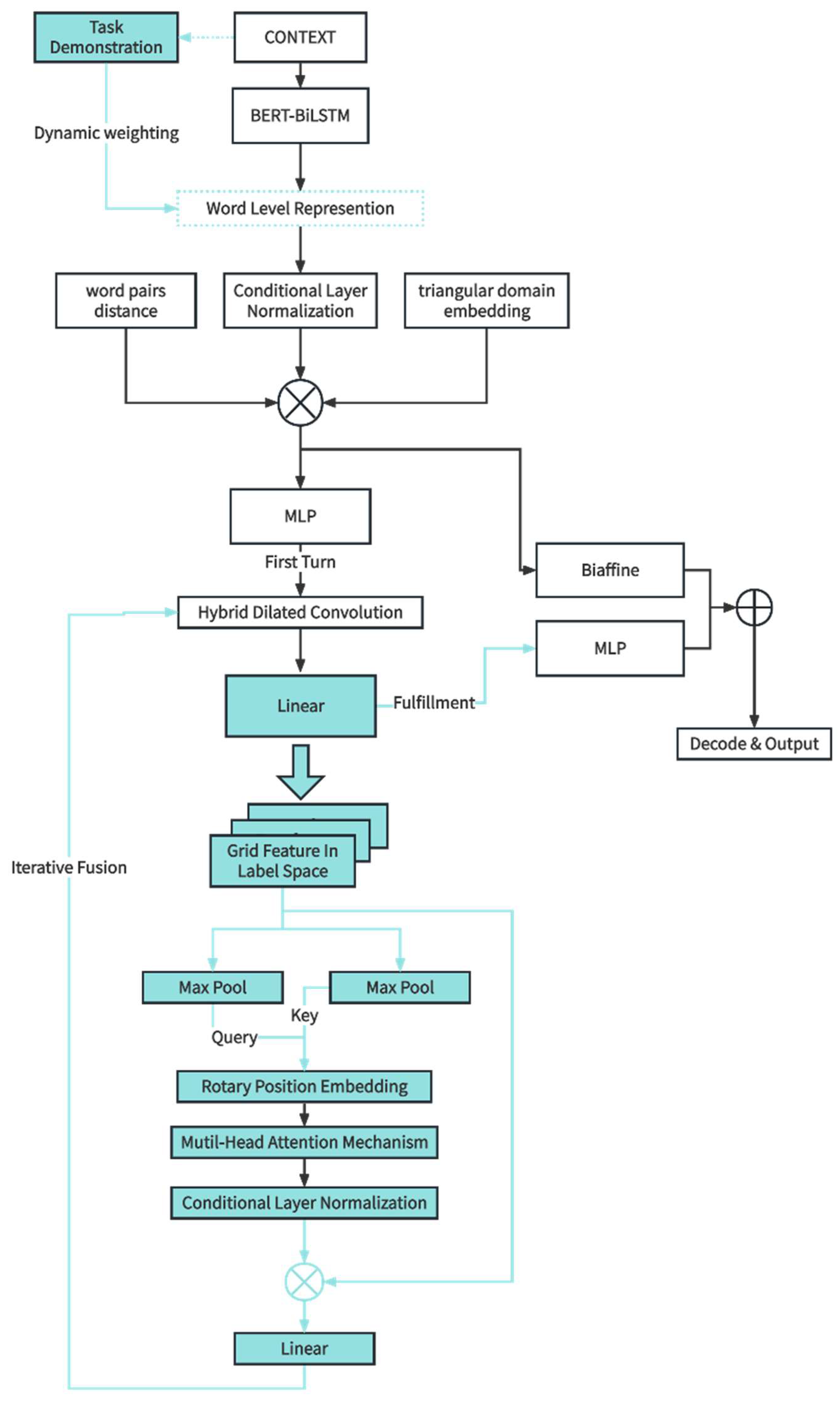


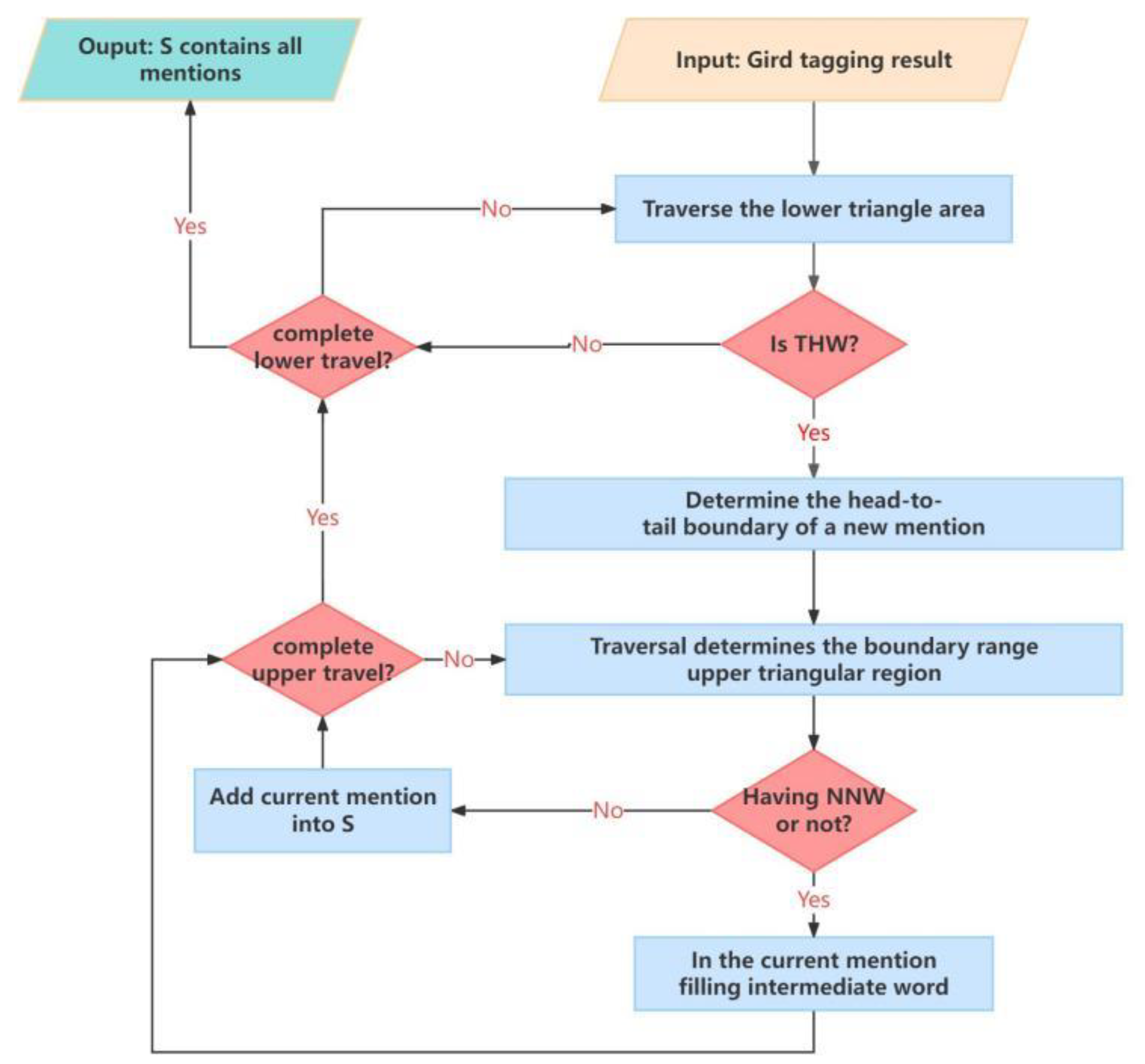

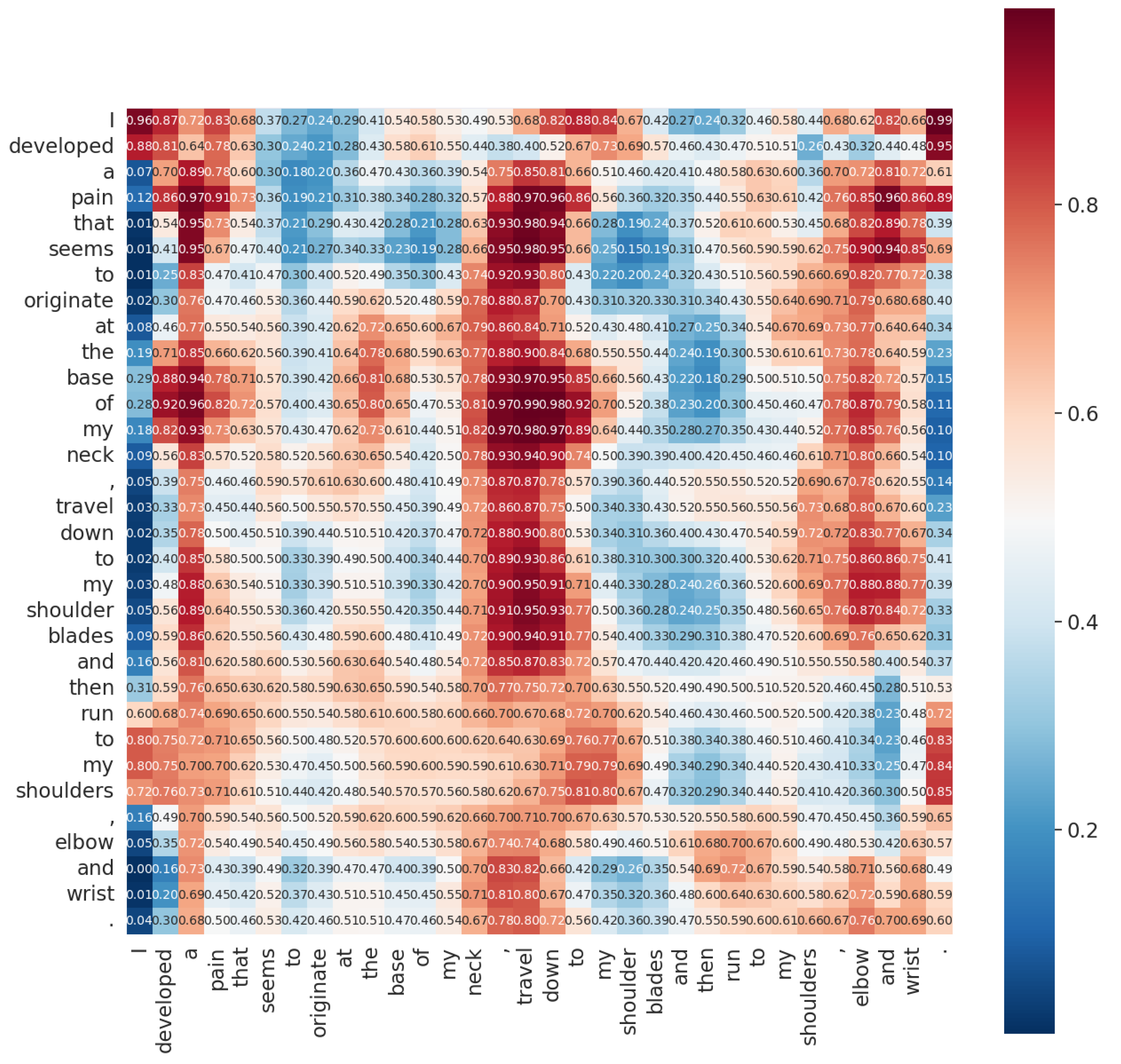

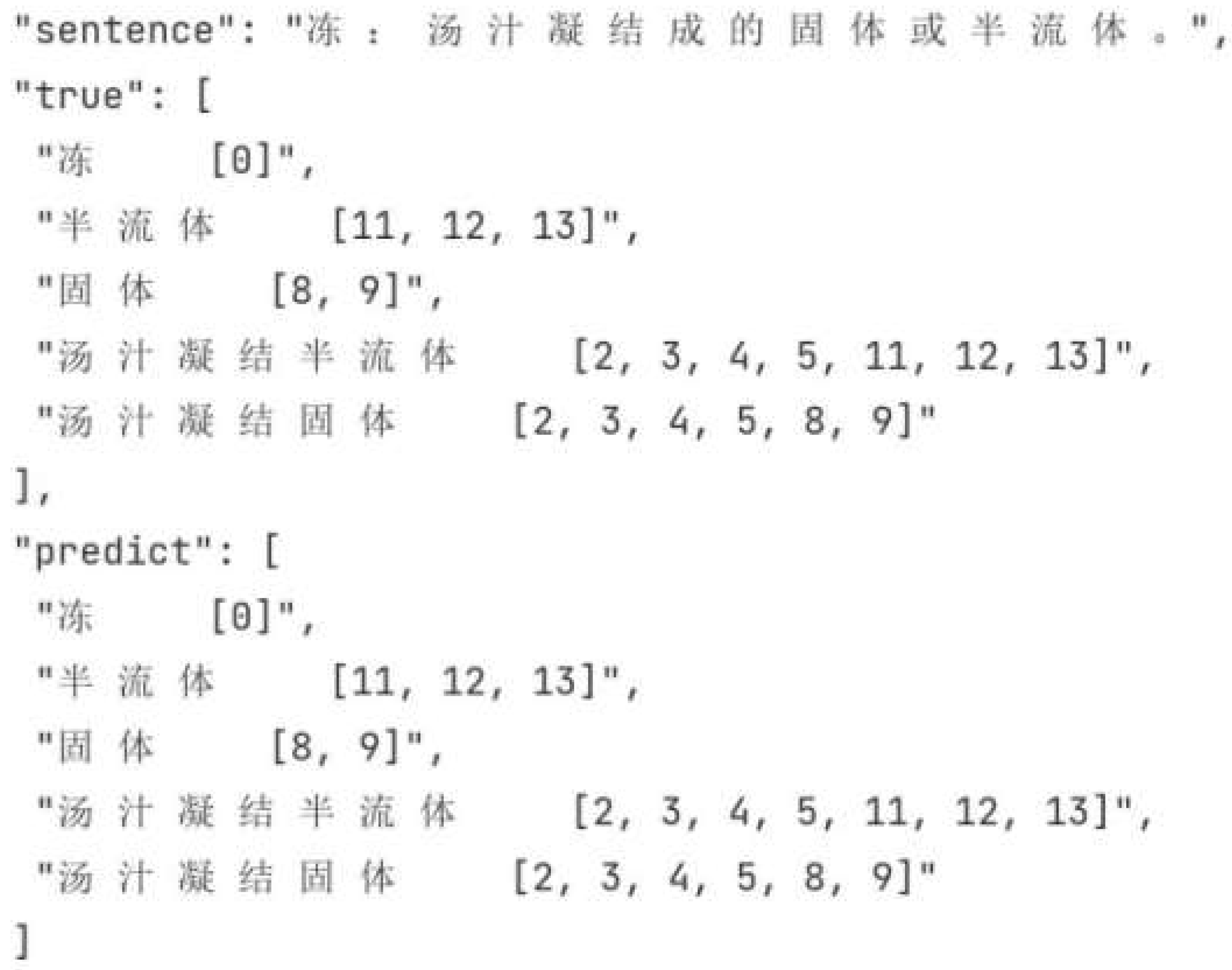
| Dataset | CADEC | CADEC-Discontinuous | Chinese Dictionary | |||||||||
|---|---|---|---|---|---|---|---|---|---|---|---|---|
| AII | Train | Dev | Test | AII | Train | Dev | Test | AII | Train | Dev | Test | |
| #Sentences | 7597 | 5340 | 1097 | 1160 | 439 | 306 | 59 | 74 | 1496 | 1036 | 230 | 230 |
| #Entities | 6318 | 4430 | 898 | 990 | 679 | 491 | 94 | 94 | 4268 | 2916 | 639 | 713 |
| #Discontinuous | 679 | 491 | 94 | 94 | 679 | 491 | 94 | 94 | 253 | 172 | 46 | 35 |
| %Discontinuous | 10.7 | 11.1 | 10.5 | 9.5 | 100 | 100 | 100 | 100 | 16.9 | 16.6 | 20.0 | 15.2 |
| Predict | Positive Samples | Negative Samples | |
|---|---|---|---|
| True | |||
| Positive samples | TP | FN | |
| Negative samples | FP | TN | |
| Model | CADEC | Chinese Dictionary | |||||
|---|---|---|---|---|---|---|---|
| P (%) | R (%) | F1 (%) | P (%) | R (%) | F1 (%) | ||
| Methods based on sequence labeling | Tang et al. 2018 [21] | 67.80 | 64.99 | 66.36 | / | / | / |
| Methods based on hypergraph | Wang and Lu 2019 [42] | 72.10 | 48.40 | 58.00 | / | / | / |
| Methods based on sequence-to-sequence | Fei et al. 2021 [43] | 75.50 | 71.80 | 72.40 | / | / | / |
| Methods based on grid tagging | Wang et al. 2021 [37] | 70.50 | 72.50 | 71.50 | 67.59 | 75.97 | 71.53 |
| Li et al. 2022 [3] | 74.09 (81.84) | 72.35 (83.80) | 73.21 (82.77) | 86.75 | 86.38 | 86.56 | |
| Ours Model | 76.87 (83.24) | 71.52 (82.94) | 74.10 (83.55) | 89.72 | 88.73 | 89.22 | |
| Model | Number of Iterations | Attention | RoPE | Demonstration | CADEC | ||
|---|---|---|---|---|---|---|---|
| P (%) | R (%) | F1 (%) | |||||
| W2NER | 1 | / | 1 | / | 74.09 | 72.35 | 73.21 |
| Ours | 6 | Y | / | / | 74.76 | 69.38 | 71.96 |
| Ours | 6 | Y | Zero | / | 76.39 | 70.91 | 73.55 |
| Ours | 6 | Y | Add | / | 75.70 | 68.24 | 71.14 |
| Ours | 6 | Y | Mul | / | 73.33 | 68.60 | 70.89 |
| Ours | 6 | Y | Zero | Random | 76.69 | 71.00 | 73.60 |
| Ours | 6 | Y | Zero | SentenceBERT | 76.87 | 71.52 | 74.10 |
| Model | CADEC-Discontinuous | |||
|---|---|---|---|---|
| P (%) | R (%) | F1 (%) | ||
| Methods based on grid tagging. | W2NER | 48.68 | 63.79 | 39.36 |
| Ours Model | 51.66 | 68.42 | 41.49 | |
Disclaimer/Publisher’s Note: The statements, opinions and data contained in all publications are solely those of the individual author(s) and contributor(s) and not of MDPI and/or the editor(s). MDPI and/or the editor(s) disclaim responsibility for any injury to people or property resulting from any ideas, methods, instructions or products referred to in the content. |
© 2024 by the authors. Licensee MDPI, Basel, Switzerland. This article is an open access article distributed under the terms and conditions of the Creative Commons Attribution (CC BY) license (https://creativecommons.org/licenses/by/4.0/).
Share and Cite
Jia, H.; Huang, J.; Zhao, K.; Mao, Y.; Zhou, H.; Ren, L.; Jia, Y.; Xu, W. Demonstration-Based and Attention-Enhanced Grid-Tagging Network for Mention Recognition. Electronics 2024, 13, 261. https://doi.org/10.3390/electronics13020261
Jia H, Huang J, Zhao K, Mao Y, Zhou H, Ren L, Jia Y, Xu W. Demonstration-Based and Attention-Enhanced Grid-Tagging Network for Mention Recognition. Electronics. 2024; 13(2):261. https://doi.org/10.3390/electronics13020261
Chicago/Turabian StyleJia, Haitao, Jing Huang, Kang Zhao, Yousi Mao, Huanlai Zhou, Li Ren, Yuming Jia, and Wenbo Xu. 2024. "Demonstration-Based and Attention-Enhanced Grid-Tagging Network for Mention Recognition" Electronics 13, no. 2: 261. https://doi.org/10.3390/electronics13020261
APA StyleJia, H., Huang, J., Zhao, K., Mao, Y., Zhou, H., Ren, L., Jia, Y., & Xu, W. (2024). Demonstration-Based and Attention-Enhanced Grid-Tagging Network for Mention Recognition. Electronics, 13(2), 261. https://doi.org/10.3390/electronics13020261






